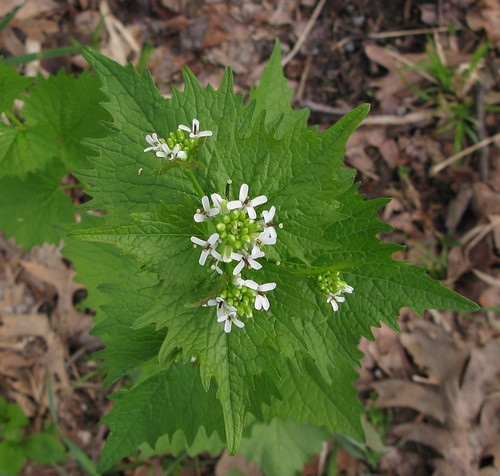
This pretty little plant is garlic mustard. It is cropping up at the edges of the south woods. And this is a bad thing. A Very Bad Thing.
I've been taking a lot of wildflower photos and poring over guides to identify them, and I've been pleased to discover so many fragile little natives on the property. However, I read the description of this one with growing alarm. There were words like introduced ... noxious ... invasive ... restricted ... rapidly spreading ... threatening to native species. Yikes.
According to Wikipedia, garlic mustard was introduced from Europe in the 1860's as a culinary and medicinal herb. (The leaves and flowers are edible, but I haven't felt the need to taste them.) Without its natural enemies, it has run rampant.
It seems the garlic mustard can take over an entire forest floor, crowding out nearly everything else. Among the natives it threatens are trillium, trout lilies, spring beauties, and Dutchman's britches. There is also an endangered species of butterfly that mistakenly lays its eggs on this mustard instead of the native kind. The garlic mustard has compounds in it that kills the larvae.
It seeds profusely, and the seeds can lie dormant for years. Deer make things worse; they eat the natives, but not the mustard. Plus, their hooves disturb the ground and create great places for the seeds to start.
The plant is so bad that many naturalist groups organize annual search-and-destroy events, sweeping through woodlands, digging up the pesty things and carrying them out in bags. I have already pulled all the ones near the road, and I'll get the ones I can see off the driveway as soon as I can.
It's not something you'll notice unless you're looking for it. From any distance, it looks like any old weed. The links below will give you a better idea of how to identify it. And if you do see this stuff, please pull it out, OK?
See The Stewardship Network for facts and to get involved in action plans:
*Garlic Mustard
*Garlic Mustard Challenge 2009






5 comments:
Oh no..I will have to go look for this awful plant...Thank you for the information...We sure so a lot of harm by introducing non-native plants and animals....Michelle
You dont see it now but this fall you will see fields of this weed. Alot of them are yellow. Have a good day Bye Bye Ed
Wow--I had no idea. I'm not sure if this plant is on Canada's west coast but I will look for it. How is it different from the regular mustard?
Michelle, please do keep an eye out for it. It's like kudzu in its destructive power. Introducing non-natives never does seem to turn out well, does it.
Ed, I'll watch for those too. So far, this one is the only one I know about that is really bad, but I'm sure there are others.
Joanna, there are a lot of plants in the mustard family, some natives and some not. I'm learning about all this via field guides that I've checked out from the library. You might try there for good info for your area?
Thanks for teaching about this invasive plant.
Post a Comment